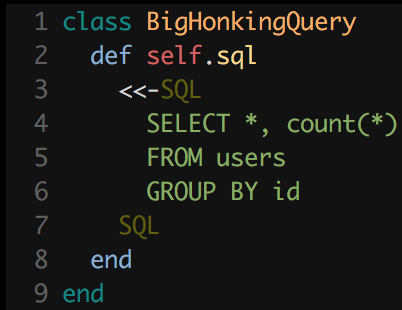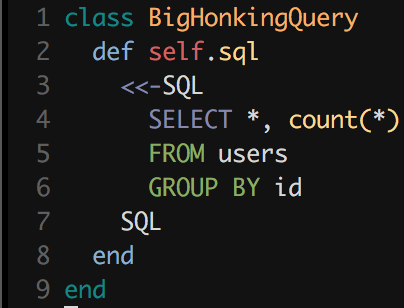Working in Rails, it’s not uncommon to have database queries that are better off expressed without using ActiveRecord. This usually means stuffing the SQL query itself into a string, and then running it against the database using ActiveRecord::Base.connection.execute. Unfortunately, these queries tend to be on the large and complex side, so having a big blob of un-highlighted SQL in the middle of your Ruby code isn’t the nicest thing.
However, there’s a loose convention on many Rails projects to denote such queries as heredoc strings starting with <<~SQL. I wanted to see if I could set up Vim to highlight that kind of heredoc in Ruby as SQL instead of a string. Turns out it’s possible!
TL;DR
Put the following in ~/.vim/after/syntax/ruby.vim
unlet b:current_syntax
syn include @SQL syntax/sql.vim
syn region sqlHeredoc start=/\v\<\<[-~]SQL/ end=/\vSQL/ keepend contains=@SQL
let b:current_syntax = "ruby"Before:

After:

Explanation
We’re using the vim after directory to run some extra syntax highlight rules for Ruby after the regular syntax/ruby.vim rules have been run. We load up the sql syntax rules into a syntax group called @SQL, then tell Vim that any region starting with a SQL heredoc string and ending with the terminating “SQL” should be highlighed by those imported syntax rules. Not bad for a couple of lines.
So what’s with the unlet / let business? Turns out that most Vimscript syntax files have a guard clause at the top that will bail out if b:current_syntax is already set (here’s the one from ruby.vim). I think this is to prevent double-sourcing of the files, but I’m not 100% sure. The practical effect here is that since the sql syntax file also contains such a guard, we needed to make sure that variable was unset so that we could properly execute that file for import here. I believe that’s what going on here, anyway—this is the point where I bailed out of digging further down the rabbithole.
Resources I found handy while figuring this out
- This article on the VimTips wiki gave me the initial idea for how this should work.
- Learn Vimscript The Hard Way has a couple great intro chapters on how Vim’s syntax highlighting works.
- Vim syntax documentation is the comprehensive (if dense) manual on the Vim syntax highlighting commands.